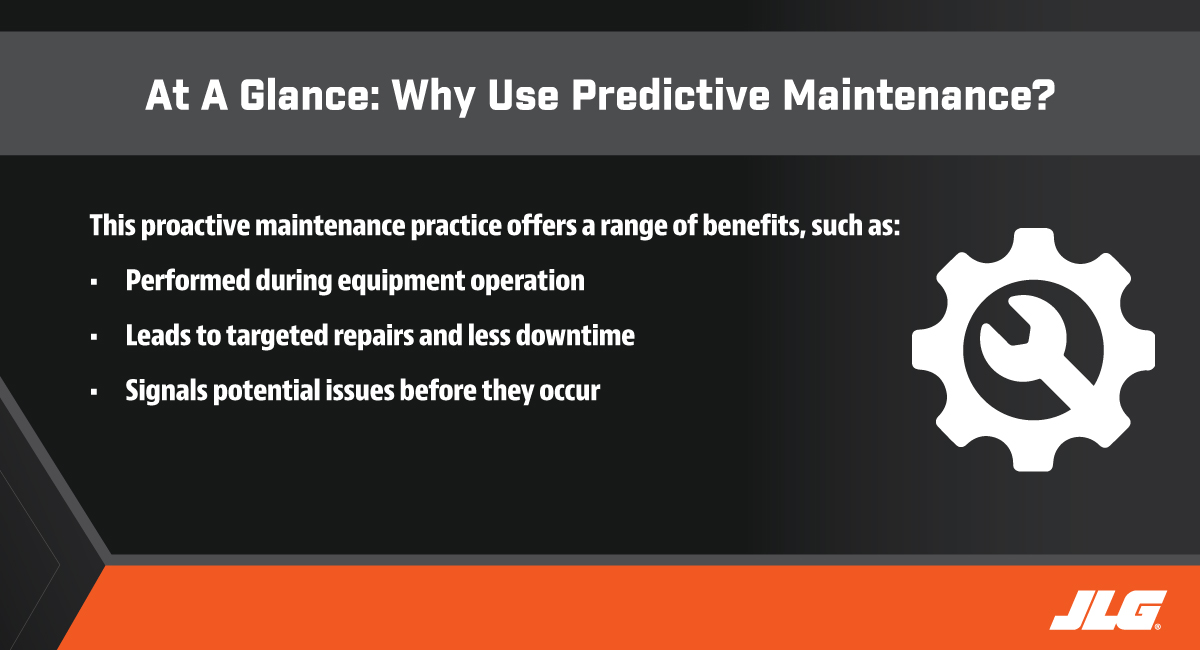 Wade Jones
Wade Jones
Sr. Director of Operations
____
JLG Industries
As technology continues to evolve, so should your maintenance practices. Equipment can now alert you when there’s a potential issue prior to any downtime occurring. Having the ability to flag issues before ever looking at the machine can be a gamechanger — and, you can do that with predictive maintenance.
As the name suggests, this type of advanced maintenance predicts equipment issues while the machine is on the jobsite and sends notifications for your team to address as needed, allowing you to prevent costly downtime. Keep reading to learn more about what predictive maintenance includes and why it matters for your business.

What is predictive maintenance?
Predictive maintenance uses real-time data from equipment with condition-monitoring technologies to indicate potential issues before they occur. This proactive, data-driven approach assesses the machine’s performance while it’s operating, which reduces the downtime needed for unplanned replacements or repairs.
This type of maintenance requires machines and technologies with interconnected measurements and data collection systems — along with team members who can analyze the data received form the machine. It’s important to establish baselines for the equipment before you start using predictive maintenance so you can identify issues when the machine operates outside of those parameters.
Predictive versus preventive maintenance
The best maintenance plans include a mixture of both predictive and preventive practices. While both maintenance strategies focus on being proactive to reduce unexpected downtime and equipment failure, there are some distinct differences between the two. Unlike preventive maintenance, predictive maintenance:
- Can be performed while the machine is in operation
- Occurs as-needed based on data, instead of following a schedule
- Has targeted downtime if an issue is detected
- Focuses on real-time equipment data—not solely on an inspection
Instead of an operator or technician signaling there’s a red flag with the equipment, the data being sent will show when there’s a potential issue. The goal of predictive maintenance is to remotely identify issues before they turn into larger ones.
Why it’s important
When used properly, predictive maintenance can alert you to future issues before even the operator knows. What might start out as a small issue can quickly turn into something bigger and more expensive to repair if not addressed, and predictive maintenance notifies teams before that happens.
Technicians will receive an alert letting them know about the specific issue. That reduces the cost of the service call because technicians can arrive with the right parts and tools to target the specified components — and may even eliminate the need for some service calls.
The equipment is able to stay in service longer, reducing revenue loss. Predictive maintenance can also improve operator safety because the data will help them decide whether a machine is in good operating condition.
This real-time data can also be used to analyze and enhance your overall maintenance practices. For example, you are notified before there is an issue with a part but not when it is still usable, improving your inventory efficiency.
Take advantage of technologies
If your equipment has the capabilities to send real-time data for analysis, you can put that information to use through predictive maintenance. Partnering with a manufacturer that offers actionable data and tools streamlines the process and expands your capabilities.
JLG is committed to providing customers with new technologies that help them incorporate predictive maintenance and perform jobs more efficiently. From our Mobile Analyzer diagnostics tool to ClearSky® telematics, we equip our customers with proactive ways to identify problems while a machine is on the jobsite. That helps to reduce unnecessary service calls and to improve equipment operations.
If you find yourself needing to troubleshoot your equipment, JLG has diagnostic and telematics tools available through OnlineExpress, a one-stop-shop for all your aftermarket needs, to help. To explore your options, click here.
Do you want to stay up-to-date with industry news and issues similar to this? Make sure you subscribe below to receive monthly updates from #DirectAccess with newly posted content so you never miss important information.